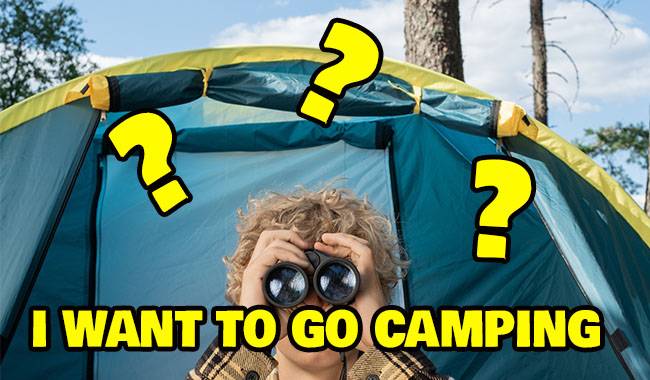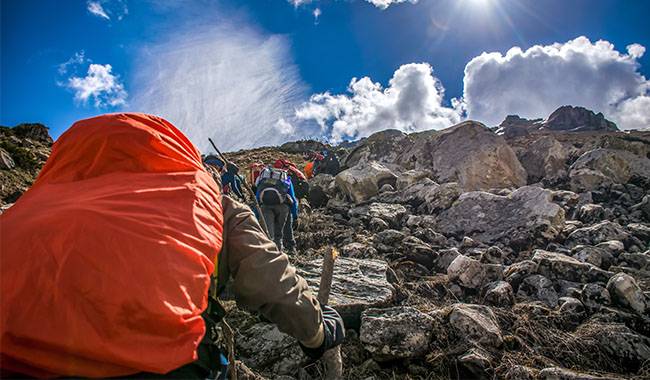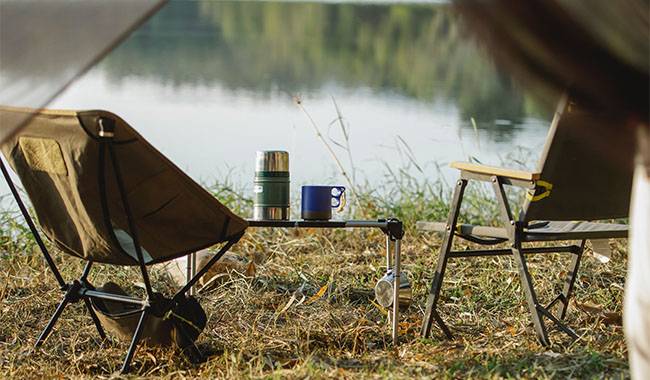
“I want to go camping, but I’m scared!” If this concerns you, let’s talk about it. Let’s look into the eyes of possible fears and try to deal with them. You will learn more about I Want to go Camping, But I’m Afraid of Danger. Discuss Public’s Worry by LCN Outdoors article.
There Are Bears
The fact is that black bears don’t show their noses in popular tourist areas and they themselves are afraid of people. For example, in South Dakota, one may only see footprints in the snow and rarely see the silhouette of a bear somewhere in the distance. On popular hikes in the Alps and Himalayas, you won’t see them. So if you are afraid of bears, choose the areas listed for your first hike, where the probability of close encounters is minimal.
If you are still afraid, read about what to do in case of a bear encounter. You will learn how to act properly and you will begin to understand these animals better.
And Poisonous Spiders
Of the 40,000 species of spiders worldwide, over 3,400 species inhabit North American countries. In the United States, there are only one species of black widow spider (Latrodectus mactans) in North America that can bite and kill: black widow venomous spiders have recently been found in at least five U.S. states: Wisconsin, Michigan, Missouri, Minnesota, and Pennsylvania. The venomous spiders found were hidden in grape packages. In other words, you don’t necessarily need to go camping to encounter a venomous black widow spider.
Other spider bites can cause allergic reactions at best. Hiking groups should always have a good allergy medication in their first aid kit just in case.
The Mountains Are Dangerous
Yes, if you don’t follow safety precautions, go places you shouldn’t and do things you don’t know how to do. That’s why it’s best to take your first hike with an experienced instructor who can tell you what you can and can’t do in the mountains.
In fact, there are not so many safety rules.
- Do not go up the mountain unprepared.
- Don’t go with anyone else.
- Don’t overestimate your strength.
You should start your hike with an easy route in an easy area. The routes for beginners are on beautiful mountain trails where there are no rocks, glaciers, or avalanches. There are many such trails in the European part. Outside our borders, the Lacey Trail in Turkey, Svaneti in Georgia, easy hikes in Nepal, and the European marked trails in the Alps, Pyrenees, and Tatras are all suitable for beginners.
I’m Afraid Of Heights
All those pictures of men climbing rock faces on cliff faces are not about hiking at all. Easy hiking trails are on good mountain trails (not the kind you see in the World’s Most Dangerous Mountain Trails series of pictures), and you’re mostly looking up, not down. So as always, the main rule is to start with the easy routes.
Tip: I know hikers who hike the hardest “pointy” peaks, but are afraid of heights. In decades of hiking, they haven’t stopped being afraid of it, but they’ve learned to take it for granted and ignore it. They also enjoy overcoming their fears, and it’s a sport for them.
It’s Hard To Get Up A Mountain, For Athletes

It’s hard for people who are new to hills, especially those who have never been friends with the sport – they lack endurance. It’s also difficult for weightlifters, sprinters, and other athletes whose lives involve heavy weights or short bursts of distance. Therefore, not every sport helps with camping. Endurance is important here, it can and should be trained, and it can be done by everyone, not just athletes.
The best endurance training is running, and the secret to good training is regularity. Running 2 miles (3.2 km) five times a week is better than running 10 miles (16 km) on the weekend and then doing nothing all week. For people who have never run before, the best time to train is three to four times a week for 3 miles (4.8 km) each time. You should start at least 3 months before your hike.
If running doesn’t work for you for some reason, you can swim, bike, or go skiing in the winter. The main thing is to do regular aerobic exercise and it should be exactly that until you are tired. The reward will be the fun of hiking – hard-working hikers always have the energy to enjoy the scenery.
Also, Backpacks Are Heavy
Even if you’re in great shape, a heavy backpack can ruin all the fun of hiking. It’s not about the beautiful views, it’s about climbing to a rest stop. There are three solutions to this problem.
- Go on trips that do not require a backpack.
- Choose lightweight equipment and not carry too much.
- Calm down and exercise more.
You can camp overnight in a shelter instead of a tent, for example, you can do this in Nepal or the Alps. In this form, you only need to carry your personal belongings and the backpack is light.
If your heart desires a full tent camping trip, it’s worth choosing the right equipment. First of all, don’t bring too much stuff, and secondly, choose lightweight equipment in a targeted way. We tell you how to do it right and where to start to avoid going broke in our article “The basics of camping”.
Sleeping In A Tent Is Not Comfortable

If you’ve never slept in a tent before, you may feel uncomfortable when you’re not used to it. But your body will get used to all the conditions – camping is usually not a problem and you will feel so tired that you will soon fall asleep. But for more comfort, you can take an inflatable pad instead of a regular foam pad – it’s much softer to sleep on, almost like you’d sleep on a mattress at home.
If staying in a tent seems like hell, there are always camping options, overnight stays in tourist shelters or hotels where you can sleep in a bed just like you would at home.
It’s Cold In The Mountains
It all depends on the area. Indeed, there are times when fresh snow falls in the mountains in mid-summer and temperatures drop below freezing, even in the lowlands.
The most important thing is to know in advance all possible weather conditions. What temperatures will be at this time of year, what altitudes you will have to spend the night at, whether there will be snow, and what weather surprises you might encounter. For example, July will have completely different temperatures in the Mount Whitney and California areas. Therefore, you will need different gear. As banal as it sounds, there is no cold weather, there is inappropriate clothing. And sleeping bags – for mountain hiking – must be chosen especially carefully.
The following are the things you need to bring to the mountains to avoid freezing.
- warm thermal underwear, fleece
- a down jacket or vest (the degree of warmth depends on the trekking area – consult your guide)
- a sleeping bag with a comfortable temperature suitable for camping conditions.
What If It Rains
Different instructors have different attitudes towards rain. Some prefer to wait for rain in their tents, while others believe that rain is no problem and you should go in any weather. But in any case, it is best to accept beforehand that it will rain.
Rain is the norm in the mountains. So are wet boots and wet clothes. It’s unpleasant, but not fatal; besides, for some reason hikers rarely get sick, even when wearing wet shoes all day.
In order to survive the rain while camping and not hate nature, you need to bring a few important things with you.
- a rain cover for the backpack.
- waterproof clothing;
- spare clothes.
- dry bag to store everything you need to stay dry.
Waterproof clothing means a membrane jacket and long pants, a rain jacket is a must (membranes sometimes get wet!) . You need to have spare clothes to change into dry clothes when you arrive at camp. You don’t need to stock up on every piece of clothing, but a spare set of thermal underwear is a must. You should have a sleeping bag in a sealed bag, as a bag for backpacking may not completely protect you from water, especially if it accidentally gets torn. It is important to keep your sleeping bag dry.
Wet shoes, on the other hand, take some time to get used to. This is not as bad as it sounds, especially if you accept it as an inevitable situation. If you really don’t want to get used to it, you can purchase either membrane or neoprene socks. Both will keep your feet warm and dry for a while, but the membrane ones will stay dry longer because they breathe.
How To Take A Shower
You don’t go to the mountains to bathe. If thousands of tourists can get away with not taking a hot shower every year, so can you.
In fact, hikers often manage to wash in the mountain rivers and even wash their hair in them. Sometimes, donkeys make it a point to take a big break in the middle of the day to shower with warm water. This doesn’t happen every day, so the rest of the time you’ll have to escape with a wet paper towel or splash water in an icy mountain stream. For more information on how to do this, see our article on hiking hygiene.
I Had No Company
The truth is, there is absolutely no problem with who you go camping with these days; the only problem is making the right choice. There are basically three options for who to go with.
- with a travel club.
- with a commercial club.
- on your own.
The third option is best postponed until you and a reliable person have been to the mountain at least a few times and know how things work in general. It’s best to start by joining a club hike where you can learn the basics of safety.
Commercial and non-commercial clubs differ not only in the cost of the trek but also in the extent to which you are involved in the preparation and “club life”. Buying a commercial tour saves time – the club takes care of all the organization and you only need to get to the starting point. In a sports club, you participate in the organization equally with everyone else, going to the mandatory training sessions, but at the beginning of the trek, you already know all the participants and have gone through all the preparation stages of a tourist freshman.
In short: commercial clubs are for those who just want to go camping, sports clubs are for those who want to dive headfirst into tourism. Take your pick, we have compiled a list of sports tourism clubs in Moscow and the USA, as well as advice on how to choose a commercial tourism organizer.
You always have a choice: go camping or don’t go. It’s easier not to go – you can stay at home and scroll through pretty pictures on Instagram. But unfortunately, others have already seen it with their own eyes and you haven’t made up your mind yet. So go for it. It’s scary, but it’s fun. And, no one is immune to making mistakes, but it’s best to learn from the experiences of others. We’ve collected all the mistakes beginners can make in one article – please read them and don’t repeat them.